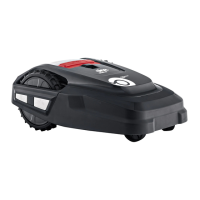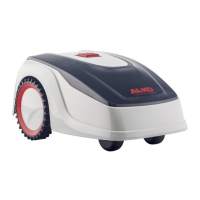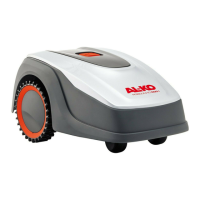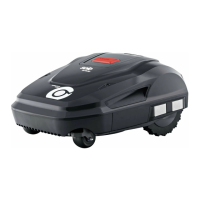at the same height as the grass surface, the cable
can be routed exactly along the edge.
Distance of obstacles from the boundary cable
(01)
If the boundary cables are precisely folded up
away from the obstacle or towards the obstacle,
i.e. distance 0 cm, the appliance moves beyond
the boundary cable. Do not cross the boundary
cables (02/c), but lay them parallel (01/e).
Routing the boundary cable around corners
(06)
■ For inwards going corners (06/a): Route the
boundary cable diagonally to avoid the
appliance becoming caught in the corner.
Assembly
■ For outside corners with obstacles (06/b):
Route the boundary cable in a point in order to
avoid a collision of the appliance with the
corner.
■ For outside corners without obstacles: Route
the boundary cable at an angle of 90°.
4.5.4 Enclosing corridors (01/h) In the
corridor the following distances must be
complied with:
■ Total width: min. 60 cm
■ Distance of the boundary cable to the edge:
20 cm
■ Distance between the boundary cables: min.
20 cm
4.5.5 Excluding downward slopes (11)
Downward slopes that are greater than 45 % must
be excluded with the boundary cable (45 % = 45
cm downward slopes per 1 m horizontally).
The boundary cable must not be laid over a
gradient of more than 20%. In order to avoid
problems when turning, maintain a distance of 50
cm to the 20% gradient. If the gradient at the outer
edge of the working area is more than 20% at any
point, lay the boundary cable on the flat ground at
a distance of 20 cm from the start of the gradient.
4.5.6 Creating loops of cable (07) Spare
loops of cable should be incorporated at regular
intervals in order to reposition the base station
or to extend the mowing area even after the
mowing area has been laid out.
Select the number of spare cable loops according
to your own judgement.
NOTE In the case of spare cable loops, do not
form open loops.
1. Lead the boundary cable around the current
lawn peg (07/1) and then back to the previous
lawn peg (07/3).
2. Then lead the boundary cable to the current
lawn peg again. This creates a loop. The
cables must be close together.
3. If necessary, attach the loop to the ground in
the middle with an additional lawn peg (07/2).
4.5.7 Typical faults in cable routing (02)
■ Spare cable loops of the boundary cable are
not laid in an even, elongated loop (02/a).
■ The boundary cable is not routed properly
around corners (02/b).
4.6 Connecting the base station to the power
source (04)
1. Place the power supply (04/4) in a dry location
that is protected against direct sunlight and
sufficiently close to the base station (04/1).
2. Connect the low voltage cable of the power
supply (04/5) and the cable of the base station
(04/6) with each other.
3. Plug the power plug of the power supply
(04/2) into a power socket (04/3).
NOTE We recommend connecting the
power supply to the mains supply via an earth
leakage circuit breaker (ELCB) with a rated
leakage current < 30 mA.
